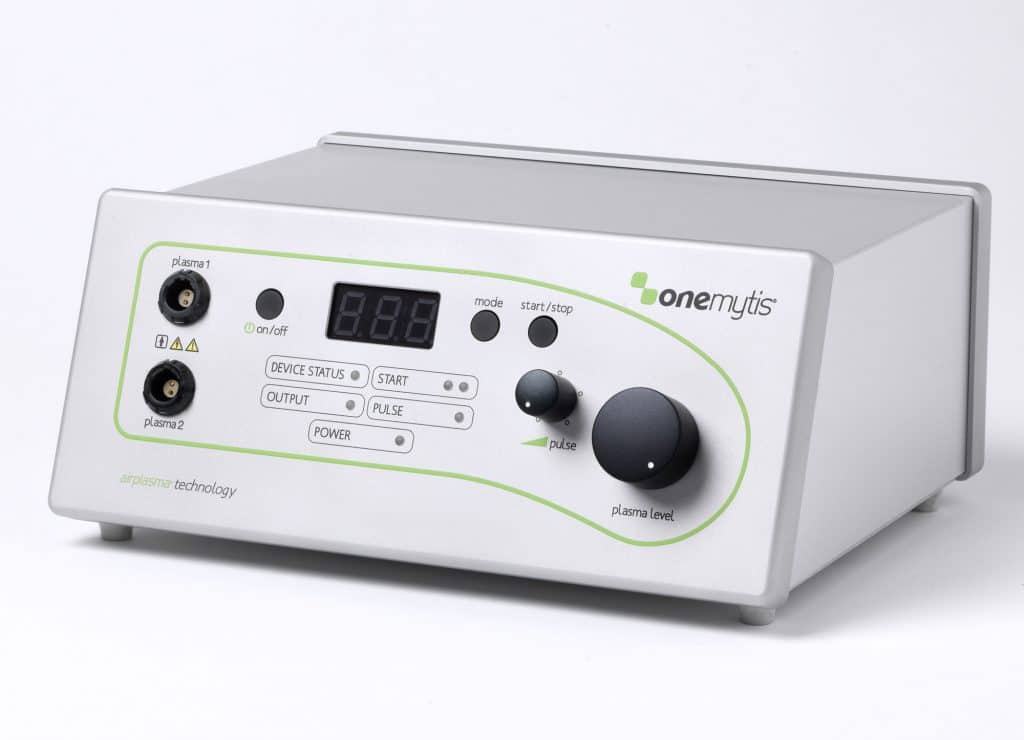Exciting claims are being made for Onemytis®, a revolutionary new surgical device that uses ‘Airplasma’ technology. But what exactly does the new technology offer and how does it compare with more established techniques?
David Flood, co-founder of Excel Lasers, who has spent 27 years specialising in devices for medical and veterinary use, provides an overview of the features of Onemytis®, and compares it to laser devices, highlighting the particular applications for which each technology is most suited.
Airplasma device Onemytis® – revolutionising soft tissue surgery
Onemytis® uses a new technology called Airplasma which releases energy (plasma) that vaporises tissue at low temperatures. It offers the most dramatic benefits in the field of soft tissue surgery. It has a cutting edge of just 0.1mm making it exceptionally precise, with the ability to remove extremely thin layers of tissue. With a maximum operating temperature of just 50c tissue damage is minimal, and the need for anaesthesia or sedation is reduced leading to faster recovery times for patients. While lasers cause less bleeding, swelling and pain than the traditional scalpel, these attributes are all taken a significant step further with the Onemytis®.
Like a laser, Onemytis® instantly coagulates small blood vessels, resulting in little or no bleeding. Larger vessels can be coagulated once they have been clamped.
All these features make Onemytis® an ideal tool for such conditions as brachycelaphic obstructive airways syndrome, creating a pocket for cherry eye, and treating skin conditions like mange. It is particularly suited to areas of fine skin, such as around the eye, and for a range of dental and aural problems, for example gingivitis, where the high temperature of a laser could damage teeth.
External growths, corns and infected skin can be easily and rapidly removed using the Onemytis® in ablation mode, when the cutting edge of the tool does not even touch the skin, and ozone molecules generated by the ionization process produce an antibacterial effect.
Lasers – a versatile tool for general surgical and therapeutic use
Surgical lasers are a versatile tool that can replace a scalpel in many cases. They are good for removing external tumours and for general surgery such as spaying and castration. They can be used for key hole surgery and for working internally in fluid-filled environments such as the bladder.
High-powered lasers are excellent for treating varicose veins and – with the addition of a special handpiece – can be used for therapeutic applications such as the treatment of sprains and arthritis. Lasers are also the tool of choice for treating equine sarcoids, as horses can be startled by electrosurgical devices.
Find out more…
Excel Lasers are the sole distributors in the UK of the Onemytis® device. If you would like to find out more please don’t hesitate to get in touch. David Flood or Steve Hayden will be happy to answer any questions and to provide a free demonstration of the Airplasma technology, after which you can try it out for yourself, under their guidance, to get the full hands-on experience.
Watch the Onemytis in action
Treatment of Oral cavity viral papiliomatosis
Ablative and non ablative skin surgery
Treating Brachycephalic Obstructive Airway Syndrome (BOAS)
Academic studies concerning plasma surgery
- Comparative Morphological Effects of Cold-Blade, Electrosurgical, and Plasma Scalpels on Dog Skin. Lacitignola, L. ( 2020) Veterinary Sciences, MDPI. DOWNLOAD>
- Histological and Morphometric Analysis of Thermal Shock Alterations in Tissue Samples obtained with the Device for Plasma Surgery named Onemytis®. (2015) Department of Veterinary Science, University of Turin. DOWNLOAD>
- Clinical Use of a New Plasma Device. Vezzoni, A. (2016) Veterinaria, SCIVAC. DOWNLOAD>


